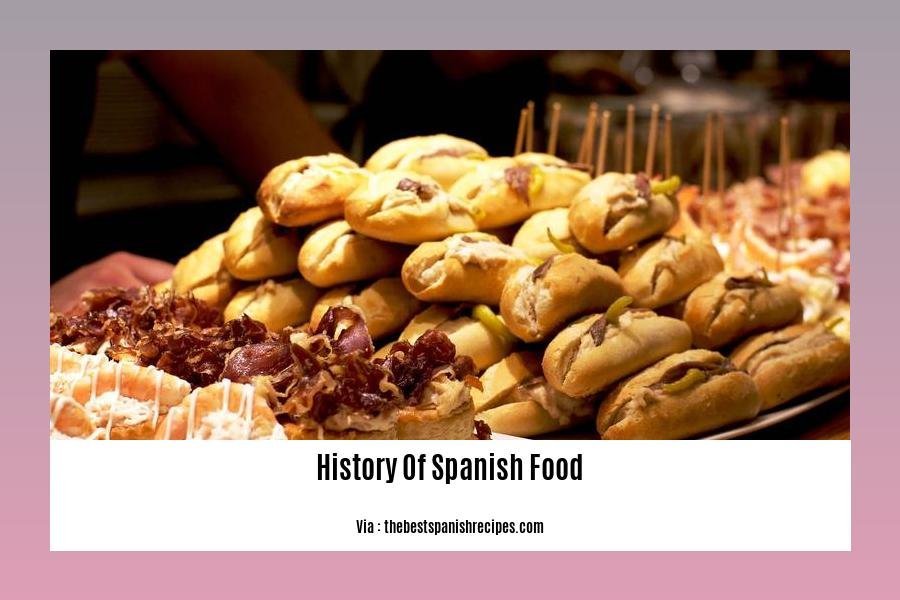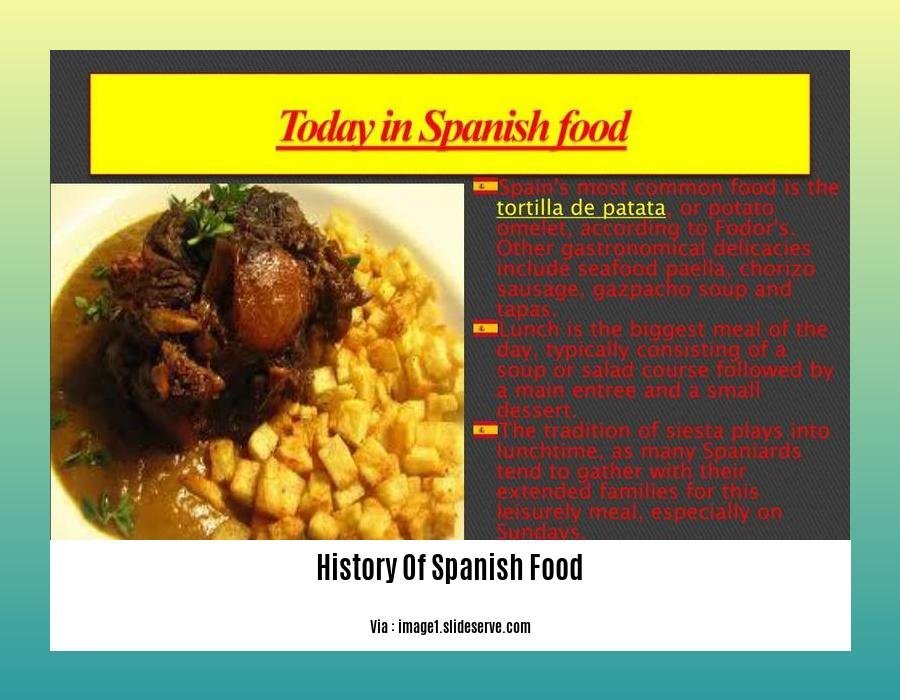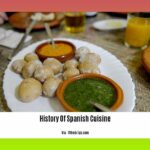Embark on a captivating expedition into the realm of Spanish cuisine with “A Culinary Journey Through Time: The Rich History of Spanish Food.” Immerse yourself in the flavors, textures, and aromas that have shaped the culinary legacy of this vibrant nation. From the ancient origins of beloved dishes to the innovative creations of modern gastronomy, our journey unveils the stories behind Spain’s rich and diverse gastronomic heritage.
Key Takeaways:
Spain’s diverse regions offer unique culinary experiences.
Spanish cuisine relies heavily on olive oil, especially in sofritos.
Herbs like parsley, oregano, rosemary, and thyme are common.
Garlic is widely used.
Popular meats include chicken, pork, lamb, and veal.
Fish and seafood are also frequently consumed.
Tapas and pinchos are popular snacks in bars and cafes.
Spain’s role in the Columbian exchange introduced ingredients like chocolate, rice, grapes, olives, and cereals to the Americas.
Ancient Spanish diets included nuts and acorns.
The Greeks and Phoenicians brought viticulture and olive oil production to Spain.
Spain is the world’s leading producer of olive oil.
History of Spanish Food

In the realm of culinary experiences, Spanish cuisine stands out as a vibrant tapestry of flavors, textures, and aromas that reflect the country’s rich history and diverse cultural heritage. Join us on a gastronomic voyage through time as we explore the captivating history of Spanish food, uncovering the influences, traditions, and culinary innovations that have shaped this beloved cuisine.
Ancient Roots:
Our culinary journey begins in ancient times when the aboriginal people of Spain relied on nature’s bounty for sustenance, foraging for nuts and acorns, the staples of their diet. As civilizations flourished, trade and cultural exchanges introduced new ingredients and techniques, enriching the culinary landscape.
The Roman and Visigothic Influence:
During the Roman Empire’s reign, Spain embraced a Mediterranean diet, incorporating olive oil, wheat, and grapes into its cuisine. The Visigoths, who ruled Spain after the fall of the Roman Empire, brought their own culinary traditions, emphasizing roasted meats and stews.
The Arrival of the Moors:
The Moorish conquest of the Iberian Peninsula in the 8th century marked a transformative period in Spanish cuisine. The Moors introduced a plethora of new ingredients and techniques, including rice, spices, nuts, and innovative irrigation systems. Their culinary legacy lives on in dishes like paella, a vibrant rice dish with Moorish roots.
The Reconquista and the Columbian Exchange:
The Christian Reconquista, which culminated in the expulsion of the Moors in the 15th century, ushered in a period of cultural and culinary blending. This era also witnessed the Columbian Exchange, where the discovery of the Americas brought new ingredients like tomatoes, potatoes, and chocolate to Spain, forever altering the course of Spanish cuisine.
The Golden Age of Spanish Cuisine:
The 16th and 17th centuries marked the Golden Age of Spanish cuisine, a period of culinary innovation and refinement. This era saw the rise of cookbooks, the establishment of culinary guilds, and the development of elaborate banquets showcasing the opulence of the Spanish court.
Modern Spanish Cuisine:
In the 20th century, Spanish cuisine underwent a culinary renaissance, with chefs like Ferran Adrià and Juan Mari Arzak leading the charge. They revolutionized traditional dishes, incorporating modern techniques and avant-garde presentations, propelling Spanish cuisine to the forefront of the culinary world.
Regional Diversity:
Spanish cuisine is renowned for its regional diversity, a reflection of the country’s varied geography and cultural heritage. From the seafood-rich dishes of the coastal regions to the hearty stews of the interior, each region offers a unique culinary experience.
The Tapas Tradition:
Tapas, small plates of savory snacks, are a quintessential part of Spanish cuisine. Originating as a way to accompany drinks, tapas have evolved into an integral part of Spanish dining culture, offering a delightful array of flavors and textures.
Conclusion:
The history of Spanish food is a captivating journey that intertwines cultural influences, culinary innovations, and regional diversity. From its ancient roots to the modern era, Spanish cuisine continues to evolve, embodying the country’s rich heritage and vibrant culinary spirit. As we savor the flavors of Spain, we not only indulge in delicious dishes but also embark on a journey through time, exploring the stories and traditions that have shaped this beloved cuisine.
Curious about how the famous Shepherd’s Pie dish started? Discover the history of Shepherd’s Pie here.
You may wonder how Spanish cuisine became what it is today, learn about the history of Spanish cuisine in this article.
Key Ingredients and Cooking Techniques in Spanish Cuisine

In the tapestry of world cuisine, Spanish food stands out with its vibrant colors, bold flavors, and an intricate blend of textures. It’s a testament to Spain’s rich history, cultural diversity, and the country’s passion for food. Let’s embark on a culinary journey to explore the key ingredients and cooking techniques that define Spanish cuisine.
Olive Oil, the Golden Elixir
Olive oil, the lifeblood of Spanish cooking, is more than just a condiment, it’s a culinary treasure. Its rich, fruity flavor and health benefits make it an indispensable ingredient in everything from simple salads to hearty stews. From the rolling hills of Andalusia to the lush groves of Catalonia, Spain is home to some of the world’s finest olive oils, each with its distinct character.
Garlic, the Aromatic Essence
Garlic, that pungent yet irresistible bulb, is another cornerstone of Spanish cuisine. Its ability to elevate the most mundane dishes into culinary masterpieces is nothing short of magical. Whether it’s sautéed, roasted, or infused into olive oil, garlic adds a depth of flavor that is both subtle and assertive.
Seafood, the Bounty of the Sea
Surrounded by the Mediterranean Sea and the Atlantic Ocean, Spain is blessed with an abundance of fresh seafood. From the succulent prawns of the Andalusian coast to the delicate clams of Galicia, seafood features prominently in Spanish cuisine. Paella, a vibrant rice dish studded with seafood, is a national treasure, embodying the country’s love for the ocean’s bounty.
Meat, the Hearty Delights
Spanish cuisine is not just about seafood; it also celebrates the richness of meat. From the succulent suckling pig of Segovia to the flavorful lamb chops of the Basque Country, meat dishes are a staple of Spanish gastronomy. Slow-cooked stews, like the hearty cocido madrileño, showcase the country’s mastery in coaxing out the essence of meat.
Cooking Techniques, the Symphony of Flavors
Spanish cuisine boasts a diverse range of cooking techniques, each contributing to its unique flavors and textures.
Paella: A vibrant rice dish cooked in a special pan, featuring seafood, vegetables, and sometimes meat.
Tapas: Small plates of savory snacks, served as accompaniments to drinks or as a light meal.
Stews: Hearty and flavorful stews, often made with meat, vegetables, and legumes, simmered for hours to perfection.
Key Takeaways:
- Olive oil is the heart of Spanish cuisine, adding rich flavor and health benefits to dishes.
- Garlic is an essential ingredient, providing depth and aroma to a wide range of dishes.
- Seafood plays a starring role, with fresh catches from the Mediterranean and Atlantic gracing Spanish tables.
- Meat dishes are equally celebrated, showcasing the country’s love for hearty flavors.
- Cooking techniques are diverse, ranging from paella and tapas to stews, reflecting Spain’s culinary heritage.
Sources:
[1] https://productsfromspain.net/
[2]
Evolution of Spanish Cuisine over the Centuries
The history of Spanish cuisine is a fascinating journey through time, showcasing the rich tapestry of culinary influences that have shaped this vibrant gastronomic landscape. From the early days of the Phoenicians and Greeks to the arrival of the Moors and the subsequent Reconquista, each era has left an indelible mark on the flavors and traditions of Spanish cooking.
A Fusion of Mediterranean Delights
In the ancient times, the Phoenicians, Greeks, and Carthaginians brought their culinary expertise to the Iberian Peninsula, introducing new ingredients such as wheat, olive oil, and wine. The Romans, with their sophisticated culinary traditions, further refined Spanish cuisine, leaving a legacy of stews, sauces, and grilling techniques.
The Moorish Influence: A Culinary Revolution
The arrival of the Moors in the 8th century marked a turning point in the evolution of Spanish cuisine. They brought with them a wealth of new ingredients and cooking techniques, including rice, spices, nuts, and irrigation systems. These influences can be seen in iconic dishes such as paella, gazpacho, and the use of spices like cumin and paprika.
The Reconquista and Cultural Exchange
The Reconquista, the Christian reconquest of the Iberian Peninsula, led to a blending of Christian and Muslim culinary traditions. Hearty stews and roasts, such as cocido madrileño and fabada asturiana, emerged during this period, reflecting the fusion of culinary influences.
Regional Diversity: A Culinary Tapestry
Spanish cuisine is renowned for its regional diversity, with each region boasting its own unique dishes and specialties. Coastal regions, like the Basque Country and Galicia, are known for their seafood delicacies, while inland areas, like Castile and León, offer hearty stews and roasts.
The 20th Century: A Culinary Renaissance
The 20th century witnessed a resurgence of interest in Spanish cuisine, with chefs like Ferran Adrià and Juan Mari Arzak leading a culinary revolution. These culinary pioneers pushed the boundaries of traditional dishes, incorporating modern techniques and innovative ingredients, propelling Spanish cuisine to the forefront of the international culinary scene.
Key Takeaways:
- Spanish cuisine has evolved over centuries, influenced by various cultures, including the Phoenicians, Greeks, Carthaginians, Romans, and Moors.
- The Moorish conquest introduced new ingredients and techniques, leaving a lasting impact on Spanish cuisine.
- The Reconquista led to a fusion of Christian and Muslim culinary traditions, giving rise to hearty stews and roasts.
- Spanish cuisine is characterized by its regional diversity, with each region boasting unique dishes and flavors.
- The 20th century saw a culinary renaissance, with chefs like Ferran Adrià and Juan Mari Arzak revolutionizing traditional Spanish cuisine.
Sources:
- The History of Spanish Cuisine
- The Evolution of Spanish Cuisine
Contemporary Spanish Cuisine and its Global Impact
Contemporary Spanish cuisine is a vibrant and dynamic culinary landscape that has taken the world by storm. Rooted in traditional Spanish gastronomy, it embraces innovation, creativity, and a global perspective, propelling Spanish cuisine to the forefront of the international culinary scene.
The Essence of Contemporary Spanish Cuisine
At the heart of contemporary Spanish cuisine lies a deep respect for fresh, seasonal ingredients, showcasing the country’s rich bounty of produce. Chefs celebrate the diversity of Spanish regions, incorporating local flavors and culinary traditions into their dishes.
Global Influences and Fusion
Contemporary Spanish cuisine is not afraid to embrace global influences, drawing inspiration from culinary traditions worldwide. Asian flavors, Latin American spices, and Mediterranean techniques are harmoniously blended with Spanish ingredients, creating a unique and captivating fusion cuisine.
Molecular Gastronomy and Modern Techniques
Chefs in Spain are pushing the boundaries of culinary artistry, employing molecular gastronomy techniques and modern cooking methods to create visually stunning and unforgettable dishes. Liquid nitrogen, foams, and spherification techniques transform traditional ingredients into innovative and unexpected culinary experiences.
The New Generation of Chefs
A new generation of talented chefs is leading the charge in contemporary Spanish cuisine, breaking away from conventional norms and challenging culinary traditions. With a focus on sustainability, farm-to-table sourcing, and a commitment to excellence, these chefs are redefining the face of Spanish gastronomy.
Global Impact and Recognition
Contemporary Spanish cuisine has garnered international acclaim and recognition, with Spanish restaurants consistently ranking among the world’s best. Chefs like Ferran Adrià, Juan Mari Arzak, and Andoni Luis Aduriz have become culinary rockstars, inspiring a new generation of chefs worldwide.
Key Takeaways:
- Contemporary Spanish cuisine blends traditional Spanish gastronomy with global influences and modern techniques.
- Chefs celebrate fresh, seasonal ingredients, showcasing the diversity of Spain’s culinary regions.
- Fusion cuisine, molecular gastronomy, and innovative cooking methods are hallmarks of contemporary Spanish cuisine.
- A new generation of chefs is leading the charge, redefining Spanish cuisine with a focus on sustainability and excellence.
- Contemporary Spanish cuisine has gained international recognition, with Spanish restaurants and chefs receiving global accolades.
Sources:
– The Evolution of Spanish Cuisine: From Traditional to Contemporary
– Contemporary Spanish Cuisine: A Culinary Revolution
FAQ
Q1: What are some of the key historical influences on Spanish cuisine?
A1: Spanish cuisine has been shaped by various civilizations throughout history, including the Romans, Moors, and Christians. Each culture left its mark on Spanish gastronomy, contributing unique ingredients, cooking techniques, and dishes.
Q2: How did the Reconquista impact Spanish cuisine?
A2: The Reconquista, the Christian reconquest of the Iberian Peninsula from the Moors, led to a blending of Christian and Muslim culinary traditions. This resulted in the development of new dishes that incorporated elements from both cultures, such as cocido madrileño and fabada asturiana.
Q3: What are some of the regional variations in Spanish cuisine?
A3: Spanish cuisine is highly diverse, with each region boasting its own unique dishes and specialties. Coastal regions are known for their seafood, such as the Basque Country’s pintxos and Galicia’s pulpo a la gallega. Central Spain is famous for its hearty stews and roasts, such as cocido madrileño and lechazo asado. The Mediterranean coast is known for its paellas, fideuás, and tapas.
Q4: What are some of the key ingredients and cooking techniques used in Spanish cuisine?
A4: Spanish cuisine is characterized by its use of fresh, high-quality ingredients, such as seafood, meats, vegetables, and olive oil. Common cooking techniques include grilling, roasting, stewing, and frying. Tapas, small plates of food, are a popular way to sample a variety of Spanish dishes.
Q5: What are some of the most famous Spanish dishes?
A5: Some of the most famous Spanish dishes include paella, a rice dish with seafood, vegetables, and sometimes meat; gazpacho, a cold soup made with tomatoes, cucumbers, garlic, and olive oil; cocido madrileño, a hearty stew with meats, vegetables, and chickpeas; and tapas, small plates of food served in bars and restaurants.
- China II Review: Delicious Food & Speedy Service - April 17, 2025
- Understand Virginia’s Flag: History & Debate - April 17, 2025
- Explore Long Island’s Map: Unique Regions & Insights - April 17, 2025
















